It never hurts to have a classic recipe at the ready. The classics are classic for a reason–they are typically awesome. Caesar Salad, Fettuccini Alfredo, Kentucky BBQ Ribs, Stairway to Heaven–all classics, and all are wonderful. In the culinary world some wild game dishes have “classic” status associated with them. One clear example is Lapin a la Moutarde–or Rabbit with Mustard Sauce.
The quick and easy of the recipe is to simmer the rabbit until tender in white wine, then add cream, mustard and herbs. The combination is heavenly. But, as hunters, we are not often blessed with the most tender rabbit right out of a fancy French market. More often than not, at least for me, I don’t even shoot rabbits; I shoot hares, a completely different species. To use a hare for a classic rabbit dish is close to heresy BUT we can do this, together.
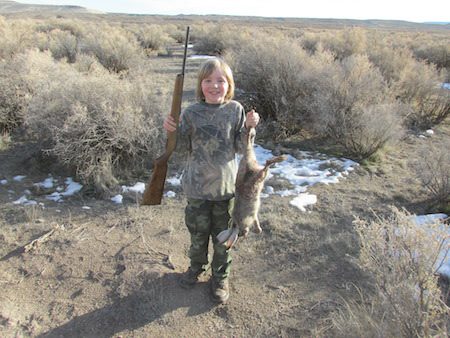 First things first, you must brine a hare for this type of cooking. Unless you stick a jackrabbit in a crock pot for 4-6 hours, you are not going to get moist and tender meat. With that said, you can brine hare meat and fool everyone in two hours. Brining artificially over-hydrates meat, thus making it moist when cooked/overcooked.
First things first, you must brine a hare for this type of cooking. Unless you stick a jackrabbit in a crock pot for 4-6 hours, you are not going to get moist and tender meat. With that said, you can brine hare meat and fool everyone in two hours. Brining artificially over-hydrates meat, thus making it moist when cooked/overcooked.
Secondly, you must debone the hare leg. In the classic rabbit dish, the thigh bone is left in. If this is done with a hare, it takes longer to cook. So, debone the leg, stuff it with thyme and mustard and tie it closed. It works great! (See the pictures attached.)
The Brine
A brine is a salty water mix that adds flavor and moisture to meat. For hares, specifically my frequent quarry the black tailed jackrabbit, I brine for at least 24 hours.
- 1 quart hot water (4 cups)
- 1/3 cup salt
- 1/4 cup brown sugar
- 1 clove garlic, smashed
- 1 sprig thyme
- 1 bay leaf
- 10 peppercorns
Stir all ingredients into the hot water. Make sure the water is as hot as your faucet can produce, or maybe even boil the water.
Let the brine cool to room temperature. Add cut up rabbit pieces*, making sure that all the meat is submerged in the brine. Refrigerate for 24 hours.
*See my blog, www.chefrandyking.com for directions on how to properly cut up a rabbit/hare.
Deboning the Hare Leg
- 2 each, hare back legs
- 2 sprigs thyme
- 1 tablespoon mustard
- Butcher’s twine
The big back legs of a wild hare are daunting. They are working muscles and are NOT tender cuts of meat. So, what does a hunter do with them?
After removing them from the body, flip them so that the inside of the thigh is facing up. You will notice a line that follows the leg bone. Starting at the ball joint cut along that line until you reach the “knee” joint. Then work the tip of the knife under the leg bone, cutting it free of the thigh.
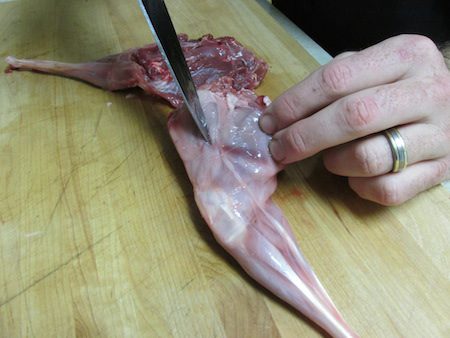
When the bone is removed from inside the thigh, it will still be connected to the knee joint. At this point I use blunt force and twist the bone until I hear the crack of cartilage, then I cut the connective ligaments and tendons and pull off the inside thigh bone.
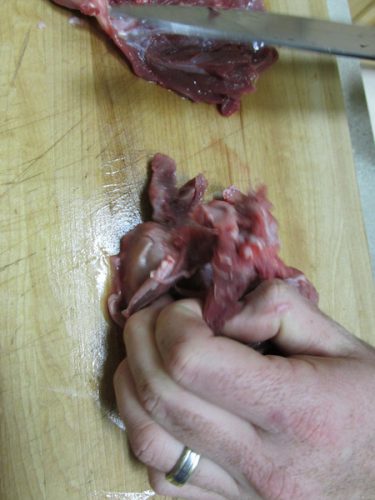
Spread open the leg meat and place one sprig of thyme into each leg. Then spread half the mustard onto each leg and tie each leg closed. Legs are now ready for the recipe.
Rabbit with Mustard Sauce
- 1 hare or rabbit cut up and brined
- Salt and pepper
- 1/2 cup all-purpose flour
- 2 tablespoons butter or olive oil
- 1/2 small red onion, small diced
- 1 cup white wine (something good, drink the remainder during dinner)
- Water
- 1/2 cup heavy whipping cream
- 3 tablespoons Dijon mustard
- 4 ea thyme sprigs (1.5 teaspoon dried)
Pat the brined rabbit dry with paper towels. Season them with salt and pepper. Roll the cuts in the flour and reserve on a dry plate.
In a medium sauté pan with a lid, heat 1/2 the butter or oil (1 T). When hot, but not yet browning, add two or three of the rabbit or hare pieces to brown. Cook each side 2-3 minutes, until a golden crust has formed. When browned on both sides, remove back to the plate. Add the remaining oil and brown the rest of the rabbit pieces.
When all the rabbit is browned, add the onion to the pan. Let it cook for 3 minutes then return the rabbit/hare pieces back to the pan and pour in the cup of white wine. Lower the heat to a simmer, and cover pan with a tight-fitting lid. Let it simmer for one hour, checking the moisture level every 10 minutes or so. Add more water if needed. After one hour, check the meat to see if it is fall-off-the-bone tender. If the rabbit or hare is more than a year old, it will probably take more time. Continue to add water and check tenderness until the meat is sufficiently tender. This should take no more than two hours.
When the meat is tender, remove it to a clean dry plate. Turn the heat up to medium-high and boil the remaining wine mix. Add the cream, mustard and thyme. Reduce the heat to a simmer and reduce the mixture to a gravy consistency. This should only take 3-4 minutes. Taste the sauce, adjust seasoning with salt and pepper as needed.
When the sauce is done, add the rabbit legs back to the pan, turn off the heat and cover with the lid. Let sit for 3 minutes. Remove legs to a platter and pour sauce over the top, garnish with fresh thyme sprigs. 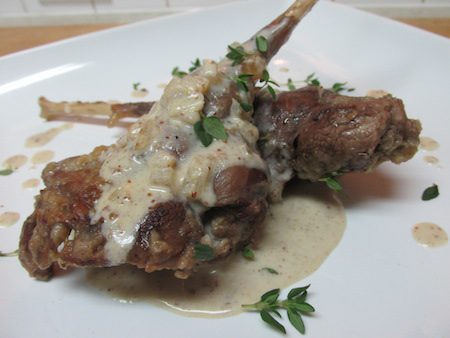





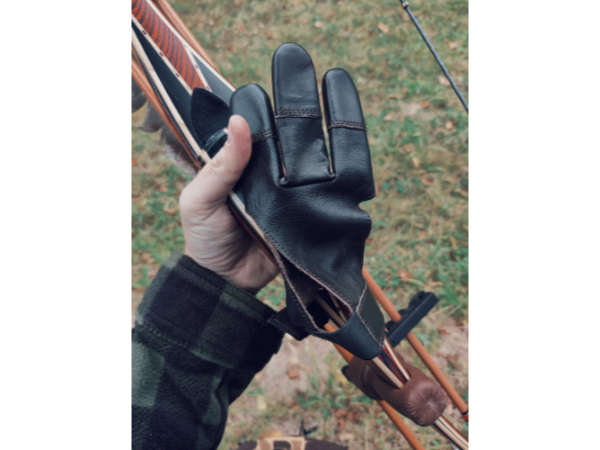

Leave A Comment